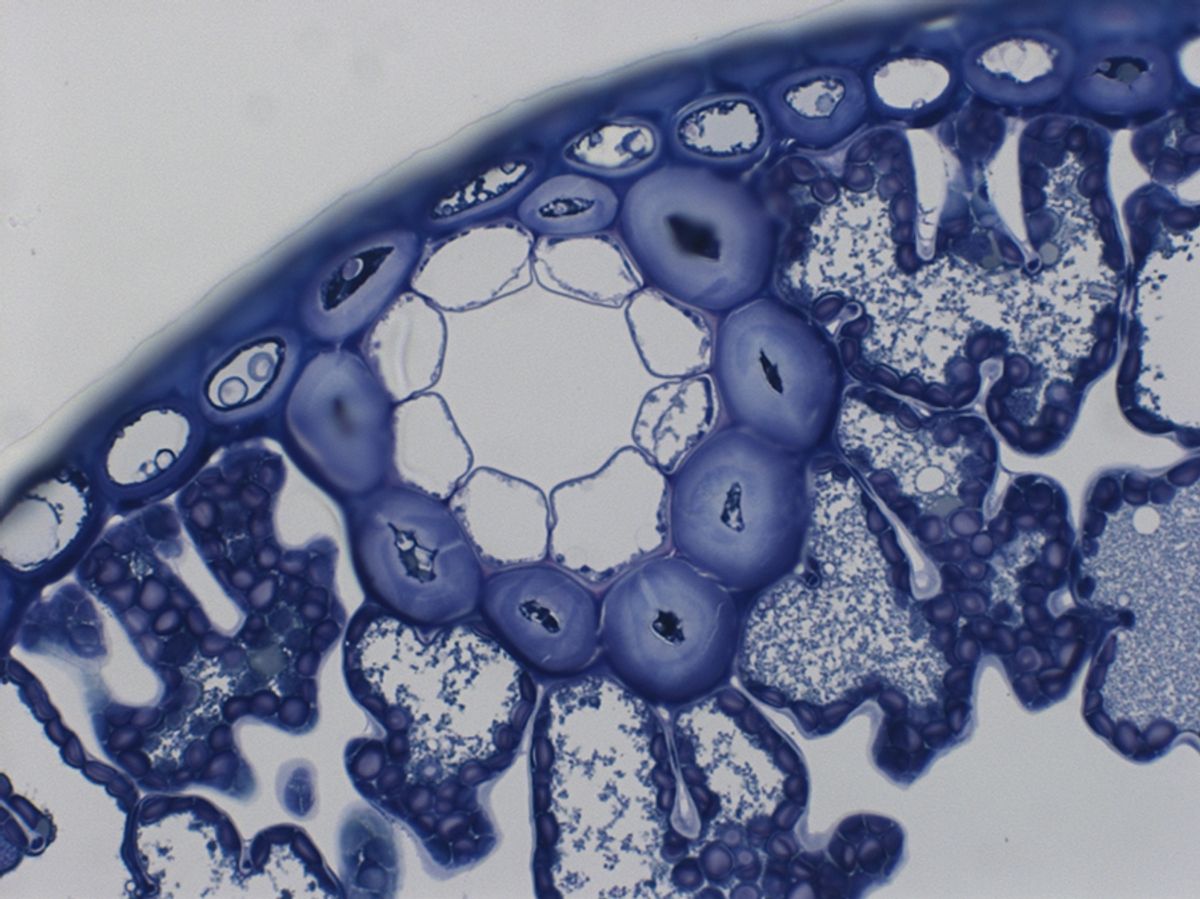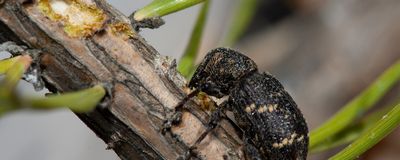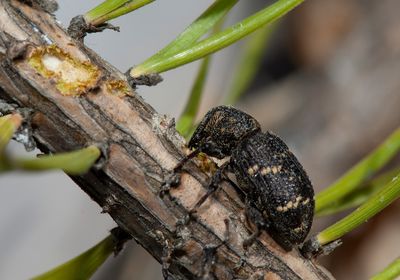ABOVE: A pine weevil (Hylobius abietis L.) chews the bark of a Scotch pine (Pinus sylvestris) sapling. Jarmo Holopainen
Rooted to the spot, trees face deathly attacks from pests, people, and even other plants without the possibility of escape. Instead, they fend off assailants with physical and chemical defenses. With insect attacks in particular, trees emit chemical compounds that, in addition to rebuffing the nibbling beast, can alert nearby predators to the presence of a tasty snack.
These herbivory-induced aromas can also warn nearby trees of impending danger, granting them the chance to steel themselves against an assault. However, this phenomenon is understudied in pines and other conifers, a group that includes many commercially and ecologically important species. Now, a group of Finnish researchers are endeavoring to rectify that, and they have produced robust evidence of conifers “priming” each other against beetle attacks using chemical signals. The findings, reported earlier this month (September 7) in Proceedings of the Royal Society B, could have significant implications for ecosystem and agricultural management going forward, the researchers say.
“It’s simply fascinating,” says Martin Volf, a community ecologist at the Biology Center of the Czech Academy of Sciences who wasn’t involved in the work. “It was really cool that they could demonstrate these herbivore signals priming [other] plants [not touched by the insects].”
The herbivores in this study were large pine weevils (Hylobius abietis L.), common pests in European coniferous forests that feed on tree bark and kill young seedlings. Clearcutting of forests amplifies the beetles’ impact; weevils reproduce in the newly created stumps and ravage the seedlings that grow in their place.
See “Beetles Warm BC Forests”
However, conifers aren’t completely defenseless against these dime-sized invaders. Much like kitchen herbs whose scent becomes more potent when crushed or broken apart, Scotch pine (Pinus sylvestris) and other trees emit fragrant molecules when herbivores chew through their bark. These molecules, known as herbivore-induced plant volatiles (HIPVs), repel the herbivore and attract its predators.
Additionally, Hao Yu, a plant ecophysiologist at the University of Eastern Finland, knew that some tree species use these volatile compounds to communicate with one another, allowing for neighbors of a besieged plant to increase their defenses against whatever animal is attacking them. However, this behavior had never been studied in conifers, which are famous for their belowground networks of fungal communication.
See “Opinion: Western Canada Must Stop Clearcutting Its ‘Mother’ Trees”
It turns out that, at least in Finland, there was a good reason for that. “During the winter months, which are quite long in Finland, these plants are not doing very much,” says University of Eastern Finland chemical ecologist James Blande, who coauthored the paper. HIPVs are best studied during the plant’s active growth period, but conifers’ incredibly narrow window of summertime growth makes running an experiment difficult.
Yu and his coauthors were up to the challenge. Working long days in the lab over the course of just a few weeks, they set up groups of Scotch pine seedlings in two separate chambers. Within each chamber, seedlings on one side were designated as “emitter” plants and the others were designated as “receivers.” Enclosing each receiver plant and randomly selected emitter plants in plastic bags, the researchers pumped clean oxygen into the bags while pulling air out at the same time in order to capture any volatiles or other gases the plants were emitting, then ran the collected gas through a mass spectrometer to identify the molecules within. In the control chamber, the researchers left all the plants alone at first, while they infested the emitter plants in the other chamber with three weevils each. After five days, the scientists removed the emitter plants from both chambers. They ran the gas emission analysis again on receiver plants, then infested the receiver plants in both chambers to test their resistance to weevils. Eighteen hours later, they measured gas emission and bark damage and took needle samples back to the lab for microscope analysis of any anatomical changes.

The researchers found that receiver saplings exposed to the HIPVs of infested emitter plants were more resistant to pine weevil damage than those not exposed to infested saplings. These exposed plants emitted more volatiles and boasted more robust resin ducts with a greater cell count. Together, the emission of HIPVs and increased resin production are a strong deterrent to invading bugs. Yu and his colleagues also found higher rates of photosynthesis (which would enable plants to generate the carbon resources needed for volatile and resin production), and increased stomatal conductance, which allows for more airflow to support photosynthesis, in receiver plants exposed to infested plants.
Combined, these results indicate that HIPVs are a call-to-arms for neighboring pine saplings, telling them to gear up for battle, says biologist Jörg-Peter Schnitzler of Helmholtz Munich Research Center who wasn’t involved in the study.
The infested tree “is sending out a so-called ‘cry for help,’ and its neighbors are somehow sensing it,” Schnitzler says. “And then [the neighbors] are priming their defense and are more active in defending against an upcoming enemy. That’s really exciting to see.”
However, anthropogenic factors may be making this chemical communication more difficult. In addition to the control and infestation chambers using ambient air, Yu and his colleagues ran the experiment in chambers with elevated ozone levels, which can be caused by car exhaust and other anthropogenic emissions. The level they used has already been observed in some areas of Europe and will likely become more widespread in the future, and therefore its effect on the trees’ defense system was important to document, the scientists write in the study. Although the pines under elevated ozone still produced more volatiles with prior exposure to infested plants than without, the plants’ photosynthesis rates, volatile emissions, and stomatal conductance weren’t as high when the amount of ozone was dialed up as they were in ambient air. To Yu, this indicates that although the message was still getting across, a receiver plant’s response in polluted areas could be dampened.
Yu says he’s planning to take his experiment out to the field to see if the same patterns he saw in the lab apply to trees living wild in the ecosystem. With more knowledge in hand about chemical communication in conifers, he says the group’s findings could have important implications for agriculture. For instance, such findings could inform efficient pesticide usage, especially in relation to local air quality.
Regardless of its potential applications, this new discovery is an important contribution to our understanding of forest ecosystems, Volf tells The Scientist. “With the ongoing global change, we need to see the effect of the changes in the abiotic environment and how [those changes] cascade in trophic interactions from plants, through herbivores, through predators,” Volf says. “And I think this study is a very valuable first step in that direction.”








